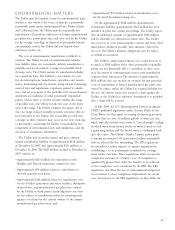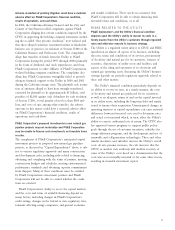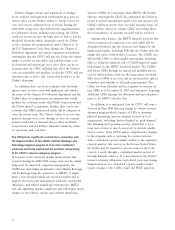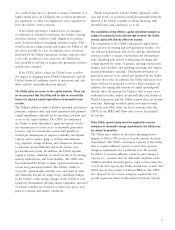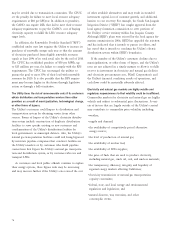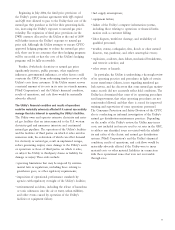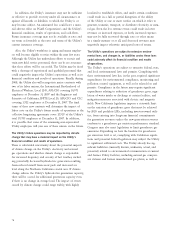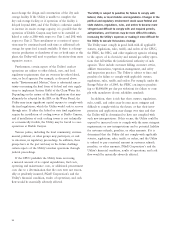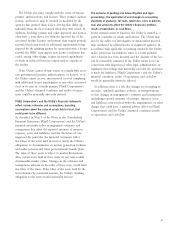PG&E 2007 Annual Report Download - page 76
Download and view the complete annual report
Please find page 76 of the 2007 PG&E annual report below. You can navigate through the pages in the report by either clicking on the pages listed below, or by using the keyword search tool below to find specific information within the annual report.74
The Utility faces signifi cant uncertainties associated with the
future level of bundled electric load for which it must procure
electricity and secure generating capacity and, under certain
circumstances, may not be able to recover all of its costs.
The Utility must procure electricity to meet customer
demand, plus applicable reserve margins, not satisfi ed from
the Utility’s own generation facilities and existing electric-
ity contracts. When customer demand exceeds the amount
of electricity that can be economically produced from the
Utility’s own generation facilities plus net energy purchase
contracts (including DWR contracts allocated to the Utility’s
customers), the Utility will be in a “short” position. When
the Utility’s supply of electricity from its own generation
resources plus net energy purchase contracts exceeds cus-
tomer demand, the Utility is in a “long” position.
The amount of electricity the Utility needs to meet the
demands of customers that is not satisfi ed from the Utility’s
own generation facilities, existing purchase contracts or
DWR contracts allocated to the Utility’s customers could
increase or decrease due to a variety of factors, including,
without limitation, a change in the number of the Utility’s
customers; periodic expirations or terminations of existing
electricity purchase contracts, including DWR contracts;
execution of new energy and capacity purchase contracts;
fl uctuation in the output of hydroelectric and other renew-
able power facilities owned or under contract by the Utility;
implementation of new energy effi ciency and demand
response programs; the reallocation of the DWR power
purchase contracts among California investor-owned electric
utilities; and the acquisition, retirement, or closure of genera-
tion facilities. The amount of electricity the Utility would
need to purchase would immediately increase if there were
an unexpected outage at Diablo Canyon or any of its other
signifi cant generation facilities, if the Utility had to shut
down Diablo Canyon for any reason, or if any of the coun-
terparties to the Utility’s electricity purchase contracts or the
DWR allocated contracts did not perform due to bankruptcy
or for some other reason. In addition, as the electricity
supplier of last resort, the amount of electricity the Utility
would need to purchase also would immediately increase
if a material number of customers who purchase electricity
from alternate energy providers (referred to as “direct access”
customers) or customers of community choice aggregators
(see below) decided to return to receiving bundled services
from the Utility.
If the Utility’s short position unexpectedly increases, the
Utility would need to purchase electricity in the wholesale
market under contracts priced at the time of execution or, if
made in the spot market, at the then-current market price of
wholesale electricity. The inability of the Utility to purchase
electricity in the wholesale market at prices or on terms the
CPUC fi nds reasonable or in quantities suffi cient to satisfy
the Utility’s short position could have a material adverse
effect on the fi nancial condition, results of operations, or
cash fl ow of the Utility and PG&E Corporation.
Alternatively, the Utility would be in a long position if
the number of Utility customers declined. On February 28,
2008, the CPUC is scheduled to vote on a proposed decision
that concludes that the CPUC does not have the authority
to reinstate the ability of the Utility’s customers to become
direct access customers because the DWR still supplies power
under the contracts it executed during the energy crisis.
The proposed decision states that the CPUC will proactively
investigate how the DWR can terminate its obligations under
the power contracts, by assignment or otherwise, to hasten
the reinstatement of direct access. Separately, the CPUC has
adopted rules to implement California Assembly Bill 117
that permits California cities and counties to purchase and
sell electricity for all their residents who do not affi rmatively
elect to continue to receive electricity from the Utility, once
the city or county has registered as a community choice
aggregator while the Utility continues to provide distribu-
tion, metering, and billing services to the community choice
aggregators’ customers and serves as the electricity provider
of last resort for all customers. No cities or counties are
currently operating as community choice aggregators, but
the San Joaquin Valley Power Authority has fi led an imple-
mentation plan and stated that it intends to begin operating
in 2008. In addition, the Utility could lose customers, or
experience lesser demand, because of increased self-generation.
The risk of loss of customers and decreased demand through
self-generation is increasing as the CPUC has approved
various programs to provide self-generation incentives and
subsidies to customers to encourage development and use
of renewable and distributed generating technologies, such
as solar technology. The number of the Utility’s customers







